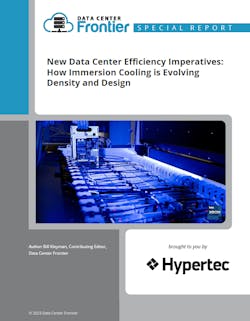Immersion Cooling: Trends That are Transforming the Data Center
Last week we launched our article series on the fundamental shift that's taking place in the way the data center industry approaches cooling. This week, we'll dive into how immersion cooling changes data center design and how immersion cooling solutions today are much different than ever before, making adoption far more feasible.
It’s not surprising that immersion cooling has been around for quite some time. But what is it, exactly? We’ll get into a few types of immersion cooling in a minute. Still, at a very high level, immersion cooling is a method adopted by data centers to quickly cool IT hardware by directly immersing it in a non-conducive liquid. The heat generated from the components is directly and efficiently transferred to the liquid. It offers the highest level of efficiency plus virtually unlimited capacity. With that in mind, it’s important to note that liquid cooling has existed since the 1970s.
EVOLUTION OF LIQUID COOLING
Between 1970 and 1995, much of the liquid cooling was done within mainframe systems. Then, in the 90s, we saw more gaming and custom-built PCs adopt liquid cooling for high-end performance requirements. Between 2005 and 2010, liquid cooling entered the data center with chilled doors. From there, looking into 2010 and beyond, liquid cooling was used in high- performance computing (HPC) environments and designs featuring direct contact and total immersion cooling solutions.
NEW BUSINESS DEMANDS TRANSLATE TO NEW INFRASTRUCTURE CHALLENGES
Across the world, connectivity and infrastructure have changed dramatically. Businesses and the corresponding infrastructure supporting digital connectivity have seen an explosion of newly remote workers working with new applications and leveraging new solutions to stay productive. For example, as the cloud evolution continues, the line between HPC, application virtualization, and even virtual desktop infrastructure (VDI) continues to blur. Technology leaders are looking for platforms that allow organizations to rethink how they deploy these critical enterprise resources to provide the maximum return on their investment and the highest end-user experience levels.
From a business and technology perspective, here are some of the critical challenges facing digital infrastructure:
- Space and time-to-market are a concern. In our introduction to the paper, we talked about a crucial statistic around data center availability and vacancy. According to DataCenteHawk, North American primary market vacancy is now averaging 4.4%, its lowest point ever, and in Northern Virginia, that vacancy rate is closer to 1%. As a result, data center leaders have been forced to rethink how they design critical infrastructure and go to market with new solutions. There is a need for space and the need to do more with that space.
- Doing more with less and finding ways to reduce OpEx. As noted in the previous point, business leaders are tasked with doing much more with less space. On top of that, there is a demand to lower operational costs by deploying more efficient technologies. Working with immersion cooling solutions can increase density while reducing cooling OpEx by over 95%. Further, immersion cooling requires less infrastructure, resulting in a 50% reduction in CapEx of build costs.
- Finding ways to maximize performance and improve data center efficiency. Energy efficiency and data center management are critical considerations for a few reasons. First, not only are data center administrators working hard to cut costs, but a significant business objective is also to minimize management challenges and improve infrastructure efficiency. To support these new initiatives, immersion cooling has become a technology to explore and implement alongside infrastructure efficiency.
- Legacy infrastructure is holding technology innovation and business planning Legacy data center solutions have a bullseye on them as they’re seen as inefficient solutions slowing down infrastructure modernization. Leaders in the data center space see that although these solutions “work,” they aren’t adding additional value to the business. It’s a key reason why modernization efforts have become front and center for business and technology leaders alike.
A key point in working with legacy IT is that you don’t necessarily have to rip it all out. New IT components can be deployed parallel to legacy IT to ensure that the transition or integration is least disruptive and beneficial to IT, users, and businesses.
This is where we pause and begin to understand the broader adoption of new solutions, like immersion cooling, aimed explicitly at modernizing today’s most critical infrastructures. New solutions are being leveraged to deliver highly efficient, high-density immersion cooling solutions to support emerging use cases around HPC, data-driven technologies, IoT, edge computing, and cloud.
In some cases, these are modular single-phase immersion-cooled data center platforms with fully integrated power, cooling, racking, networking, and management experience backed by partnerships with numerous industry leaders. Modern immersion cooling solves a combination of challenges, including the following:
- Sustainability-minded design goals
- Governmental regulation
- Rising power costs
- Technological demands for cooling cutting-edge CPUs and GPUs
- The need for more efficient and less power- hungry cooling systems is clear.
Download the full report, New Data Center Efficiency Imperatives: How Immersion Cooling is Evolving Density and Design, featuring Hypertech, to learn more. In our next article, we'll explore some of the new advancements around immersion cooling and how they help overcome the above challenges. In a special mini-section, we’ll bust some older immersion cooling myths.
About the Author




